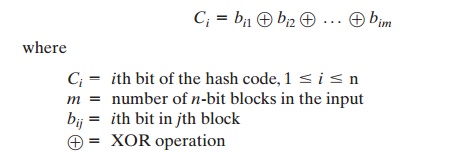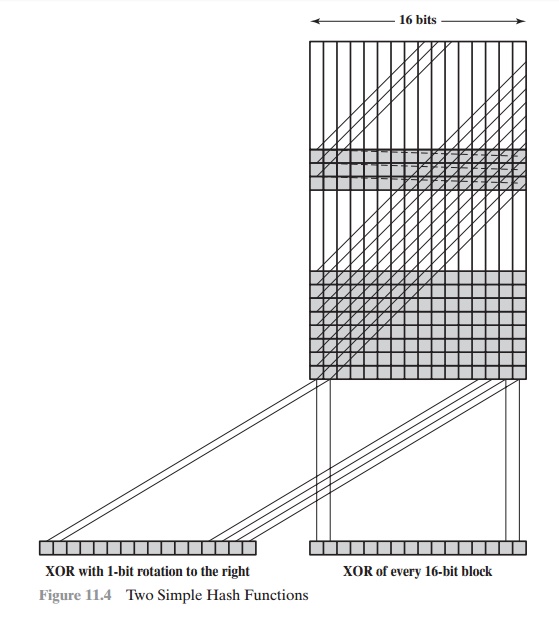Chapter: Cryptography and Network Security Principles and Practice : Cryptographic Data Integrity Algorithms : Cryptographic Hash Functions
Two Simple Hash Functions
TWO SIMPLE HASH
FUNCTIONS
To get some feel for
the security considerations involved in
cryptographic hash functions, we present two simple, insecure hash functions in
this section. All hash functions operate using the following general
principles. The input (message, file, etc.) is viewed as a sequence of n-bit blocks. The input is processed one block at a time in an iterative fashion
to produce an n-bit
hash function.
One of the simplest hash functions is the
bit-by-bit exclusive-OR (XOR) of every block. This can be expressed as

This operation produces a simple parity for
each bit position and is known as a
longitudinal redundancy check. It is reasonably effective for random data as
a data integrity check. Each n-bit
hash value is equally likely. Thus, the
probability that a data error will result in
an unchanged hash value is
2-n. With
more predictably formatted data, the function is
less effective. For example, in
most normal
text files, the high-order bit
of each octet is always zero. So if a 128-bit hash value is
used, instead of an effectiveness of 2-128, the hash function on this type
of data has an effectiveness of 2-112.
A simple way to improve
matters is to perform a one-bit circular
shift, or rota- tion, on the hash value after each block is processed. The procedure
can be summa- rized as follows.
1.
Initially set the n-bit hash value to zero.
2.
Process each successive n-bit
block of data as follows:
a.
Rotate the current
hash value to the left by one bit.
b.
XOR the block into
the hash value.
This has the effect of “randomizing” the input more completely and overcoming any regularities that appear in the
input. Figure 11.4 illustrates these two types of hash functions for 16-bit
hash values.
Although
the second procedure provides a good measure of data integrity, it is
virtually useless for data security
when an encrypted hash code is used with a plaintext

message, as in Figures 11.2b and 11.3a.
Given a message, it is an easy matter to produce a new message that yields that
hash code: Simply prepare the desired alternate message and then append an n-bit
block that forces
the new message
plus block to yield
the desired hash
code.
Although a simple XOR or rotated XOR (RXOR) is insufficient if
only the
hash code is encrypted, you may still
feel that such a simple function
could be useful when the message together with the hash
code is encrypted (Figure 11.2a). But you must be careful. A technique originally proposed by the National Bureau of Standards
used the simple XOR applied to 64-bit
blocks of the message and then an encryption
of the entire message that used the cipher block chaining (CBC)
mode. We can define the scheme
as follows: Given a message M
consisting of a sequence of 64-bit blocks X1, X2, Á , XN, define the hash code h = H(M) as
the block-by-block XOR of all blocks and
append the hash code as the final
block:
h = XN+1 = X1 Ⓧ X2 Ⓧ Á Ⓧ XN
Next, encrypt the entire message
plus hash code using CBC mode to produce the encrypted message Y1, Y2, ..... , YN+1. [JUEN85] points out several
ways in which
the ciphertext of this
message can be manipulated in such a way that
it is not detectable by the hash code.
For example, by the definition of CBC (Figure
6.4), we have

Because the terms
in the preceding equation can be XORed
in any order, it follows that the hash code would not change if the ciphertext blocks were permuted.
Related Topics